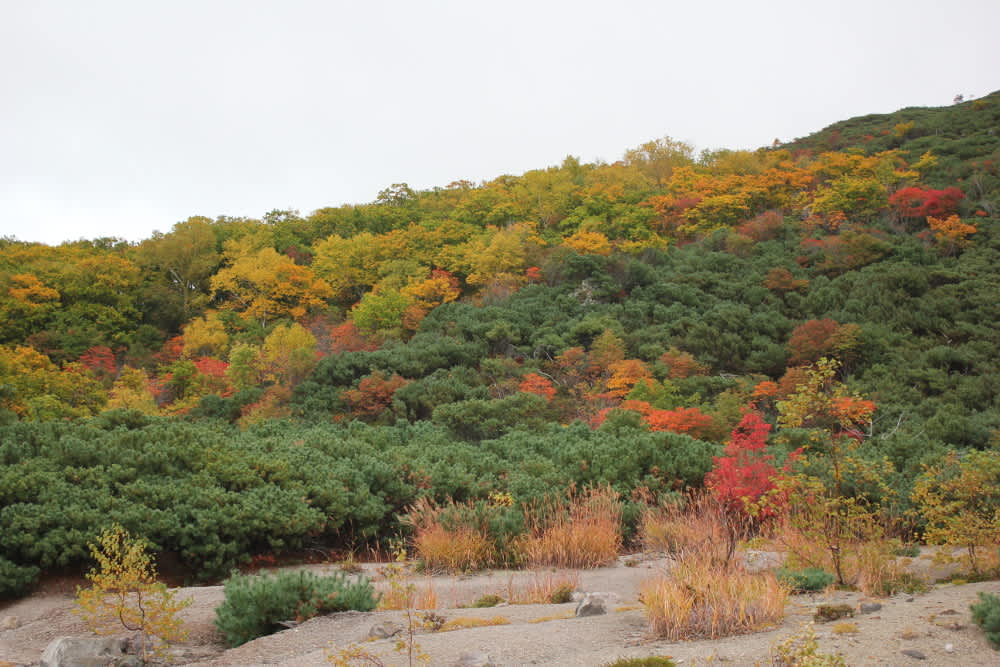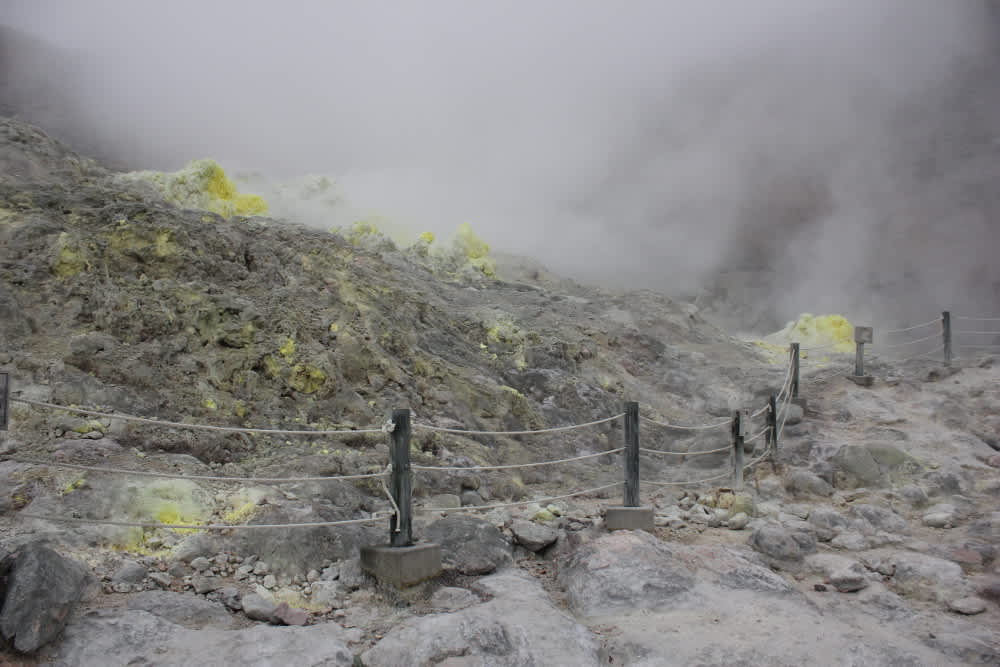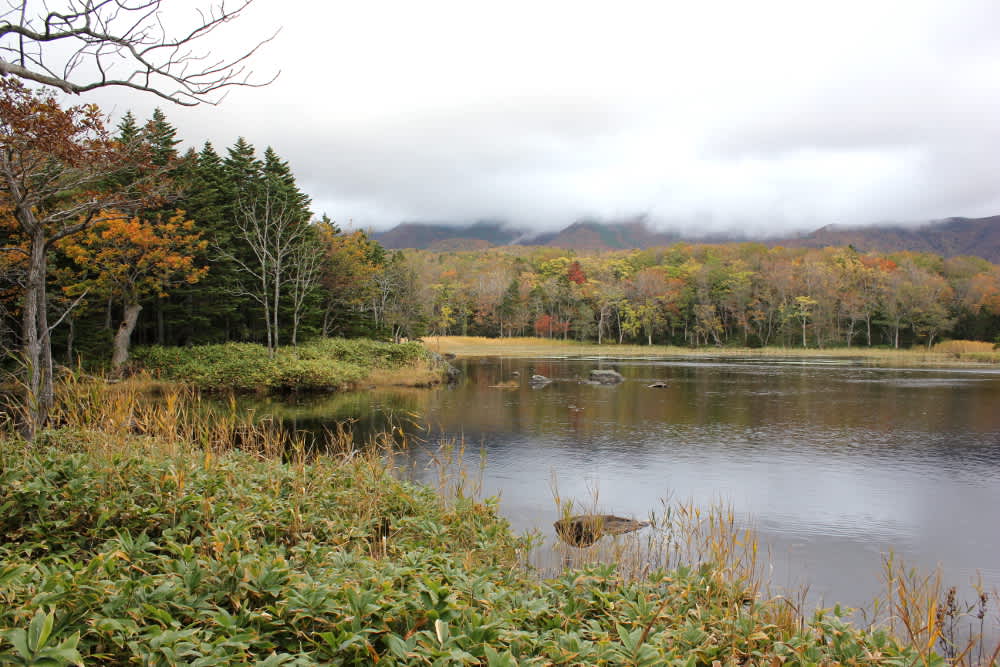Read part 1: Journey to Eastern Hokkaido here.
We drove towards Shiretoko Peninsula – considered to be Japan’s last unexplored region. The name ‘Shiretoko’ comes from the Ainu (the indigenous people of Hokkaido) word siretok, meaning ‘end of the earth’, and its a fitting name for the north-easternmost point of Japan (excluding the Northern Territories). The peninsula juts out into the Sea of Okhotsk and is a UNESCO World Heritage Natural Site, home to one of the world’s richest integrated ecosystems.
Mt Iou
On the way to Shiretoko we drove through the town of Teshikaga and saw some nice autumn colours on the way. We made a brief stop at Mt Iou, an active volcano with a height of 512 metres. The mountain is officially called Mt Atosanupuri, but it came to be known as Mt Iou, because iou means sulphur and the site used to be a sulphur mine.
The mountainside is dotted with an unnaturally bright yellow patches due to the sulphur, and sulphurous fumes rise out of the many steam vents on the ground.



Shiretoko
It was late afternoon when we arrived, so we checked into our hotel and ate dinner.
Night Animal-watching Tour
Our first activity in Shiretoko was a night animal-watching tour offered by the Shiretoko Nature Office. It’s 3,000 yen for a 2 hour bus tour (8-10pm). You ride along in a small bus driven by your nature guide. They provide binoculars and large torch-lights. Using the torch, you scan the woodland for reflections (animal eyes) until you find something!
Driving into the National Park area, we heard the cry of a Blakiston’s Fish Owl, the largest owl in the world, and native to Hokkaido. Unfortunately we did not see it, but we heard it over the wind. Only 140 of these rare birds live on Shiretoko, and there are only 1,000 left in the whole world.
We were told that it was likely that we’d see deer and possibly foxes. 10,000-20,000 deer live in Shiretoko, which is more than the human population there!
We saw two foxes. Our guide Fujikawa-san told us that there weren’t as many foxes this year because there were fewer acorns. Fewer acorns meant fewer mice and fewer foxes.
Sure enough we did see some deer:

Other than deer and foxes, we were hoping to see a tanuki (raccoon dog) or a higuma (brown bear), but we didn’t.
Hotel Shiretoko
We stayed the night at Hotel Shiretoko, a slightly dated large (271 room) Western-style hotel (3.5 star) with hot spring baths. The hotel seems popular for large groups. The hotel staff were surprisingly international and spoke English well. The rooms don’t have in-room Wi-Fi unfortunately, but it’s available in the lobby.

Dinner was a buffet which I love! They even had scallops and crab too!

Bear Country
The next morning we were supposed to go on a bear-watching cruise along the Shiretoko Peninsula but it was cancelled due to wet weather and the waves being too high. Imagine our disappointment!
We decided to drive around Shiretoko instead, trying to spot a bear in the wild. Amazingly, we did see one from a distance, a juvenile brown bear clambering down the cliff-side to the river, where he started to fish for his lunch.
Brown bears (ezo-higuma) are Japan’s largest land-dwelling mammals, and live exclusively in Hokkaido. Despite their huge size, the brown bears of Hokkaido are actually quite shy, and tend to only attack when startled.
They’re omnivorous and on Shiretoko Peninsula their diets consist mainly of plants, ants and other insects, salmon, trout and other fish. In some seasons they may also hunt deer, but they are mainly foragers.
Brown bears can be extremely dangerous, so were were told that the best form of protection is to avoid an encounter altogether.
Bear safety guidelines:
- Do not enter in early morning, evening or during conditions of low visibility.
- Do not litter, or take food into the area.
- While guide-dogs are permitted by law, it’s not recommended as bears are attracted to their scent.
- Make noise and talk loudly while walking.
- If you encounter a bear, do not run away as it triggers the bear’s instinct to chase. Be calm and move away slowly.
- Do not feed the bears.


Shiretoko Five Lakes
We went on a guided walking tour of around the Shiretoko Goko (Five Lakes), again with Fujikawa-san of the Shiretoko Nature Office. It’s a beautiful location – five volcanically formed lakes surrounded by pristine forest.
There are two options; walking on an elevated boardwalk (round trip 1.6km) and walking on the ground (long 3km & short 1.6km courses available).
Before going on the walk, we had to watch a 10 minute video, in Japanese with English subtitles. It was basically about bear safety, basically drumming home the message: “The best way to stay safe from bears is to avoid an encounter with one!”
At certain times of the year, such as when bears are most active (10 May to 31 July), you can only do the ground walks with a certified guide. At other times of the year you can do it yourself, provided you watch the 10 minute video (from park’s opening to 9 May and 1 August to 20 October). From 21 October to the park’s closing, you can do the walk yourself without watching the video. You can do the elevated boardwalk trail year-round without supervision, so it’s great for families with children and those who are less mobile.
If taking the ground path, you have to stick to the prescribed pathways to preserve the vegetation.
Fujikawa-san kept saying that we did NOT want to encounter a bear. And yet, we kind of did. He asked us to empty or pockets and bags of any food (even wrapped sweets) and any drinks other than water or tea were forbidden.
“The bears have a great sense of smell for sugar,” he explained.
We set off on the trail, and our first stop was Goko, Lake #5.



Along the way, we saw squirrels and some birds. Fujikawa-san had a hidden talent: bird whispering. Using his mouth to make a bird call, he called a whole bunch of birds over to a nearby tree. It was pretty cool to see!

We saw a Mandarin Duck here.

If you take the elevated boardwalk, you actually start at Lake #1. There are several photo spots along the way.

I was sad to leave Shiretoko and move onto our next destination, because the weather was finally clearing up.
Shiretoko is well worth visiting in any season but I think it would look spectacular in the summertime! If you’re interested in nature, walks and wildlife (especially birds), Shiretoko should be on the top of your bucket-list.
Words and images by Stephanie Sng, JNTO Sydney Office staff.
About Travellers Blog
Travellers Blog entries are submitted by travellers communicating their travel experiences in Japan and are published ‘as is’. Opinions written do not necessarily reflect those of JNTO. If you wish to submit a blog, please submit an enquiry through the contact us page.




























































